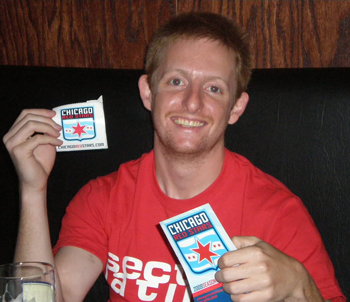| Sun | Mon | Tue | Wed | Thu | Fri | Sat |
|---|---|---|---|---|---|---|
| 1 | 2 | 3 | 4 | 5 | ||
| 6 | 7 | 8 | 9 | 10 | 11 | 12 |
| 13 | 14 | 15 | 16 | 17 | 18 | 19 |
| 20 | 21 | 22 | 23 | 24 | 25 | 26 |
| 27 | 28 | 29 | 30 | 31 |
CATEGORIES
RECENT ENTRIES
BLOG ROLL
Toe hold
Soccer blog editor Tom Dunmore, AM'02, knows a thing or two about World Cup fever.
 With Landon Donovan’s heroics in Wednesday’s must-win soccer match prolonging U.S. participation in the World Cup, we have until at least Saturday to prove to our European/South American friends that we really do care about the world’s game. Really, we do. And we know it should be called “football,” thank you very much.
With Landon Donovan’s heroics in Wednesday’s must-win soccer match prolonging U.S. participation in the World Cup, we have until at least Saturday to prove to our European/South American friends that we really do care about the world’s game. Really, we do. And we know it should be called “football,” thank you very much.
Donovan’s goal qualified the U.S. for the knockout round of the tournament, meaning you can (kind of) make the argument that the U.S. is among the 16 best footballing nations in the world. Doctoral student Tom Dunmore, AM’02, may be one of its most soccer-savvy residents and one of the most engaged fans in Chicago.
The editor of the award-winning soccer blog Pitch Invasion and chairman of Section 8, the Chicago Fire supporters' association, Dunmore has his hands full year-round, even without the World Cup to contend with. He’s also writing a soccer encyclopedia. (The final draft will be submitted after the World Cup, so Dunmore can include it.)
The blog—it's updated multiple times a day by Dunmore, several contributors, and an associate editor—covers soccer in the way Freakonomics looked at economics. “The idea was to look at soccer from more of a cultural perspective. We don’t really do game analysis or breakdowns of games or recent trades,“ Dunmore told me over the phone Tuesday. “We look at issues of gender, race, how they intersect with the game. There are endless intersections with society that are quite interesting...looking at the development of the game in the U.S., how it’s growing.”
Part of his goal is writing stories the mainstream U.S. media doesn’t cover—America’s familiar it’s-World-Cup-time-so-I-care-about-football conundrum—and it’s pretty hard work. “It takes up a lot of time, but through doing it I’ve gotten an awful lot of positive feedback and we’ve covered some stories that people might not have heard about,” he says, like this argument for why more statistical analysis won't improve soccer's visibility in America, no matter what ESPN says.
Dunmore, who's lived in America since 2001—a span of three World Cups—cites this year's competition as "definitely the most excitement I’ve seen. I’ve noticed a lot more places around town showing the games.”
Soccer is also getting more popular at the U of C. (Dunmore remains enrolled at the U of C, although he admits his dissertation—on U.S. foreign policy in the 1970s—hasn’t been a priority lately. “It’s really fallen off the radar for me the last year; I miss doing some of that,” he says.) With a lot of graduate students from overseas, there are often pick-up games on campus, if you know where to look. “There were a few of us who were getting a bit long in the tooth to be out there, especially in the hot sun of the summer," says Dunmore. "But there’s definitely a big culture of playing and it’s growing in [terms of] following the game."
A Brighton and Hove Albion fan as a kid, Dunmore believes one should root for the local team, wherever "local" happens to be—hence his involvement with the Chicago Fire. As for his take on the soccer/football debate, he keeps with the home-pitch advantage, calling the game soccer in the U.S., especially because “there’s already a more popular sport called football.”
Don’t worry, Tom, we know what it's really called. Besides, American football hasn’t really been that popular at the U of C since we dropped out of the Big 10 waaay back in 1939.
Asher Klein, '11
June 24, 2010
